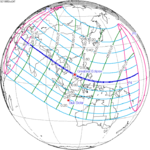Solar eclipse of October 24, 1995
| Solar eclipse of October 24, 1995 | |
|---|---|
 | |
| Type of eclipse | |
| Nature | Total |
| Gamma | 0.3518 |
| Magnitude | 1.0213 |
| Maximum eclipse | |
| Duration | 130 s (2 min 10 s) |
| Coordinates | 8°24′N 113°12′E / 8.4°N 113.2°E |
| Max. width of band | 78 km (48 mi) |
| Times (UTC) | |
| Greatest eclipse | 4:33:30 |
| References | |
| Saros | 143 (22 of 72) |
| Catalog # (SE5000) | 9498 |
A total solar eclipse occurred on October 24, 1995. A solar eclipse occurs when the Moon passes between Earth and the Sun, thereby totally or partly obscuring the image of the Sun for a viewer on Earth. A total solar eclipse occurs when the Moon's apparent diameter is larger than the Sun's, blocking all direct sunlight, turning day into darkness. Totality occurs in a narrow path across Earth's surface, with the partial solar eclipse visible over a surrounding region thousands of kilometres wide. The path of totality went through the Middle East, Asia, Indonesia.
Images
Related eclipses
Solar eclipses 1993-1996
This eclipse is a member of a semester series. An eclipse in a semester series of solar eclipses repeats approximately every 177 days and 4 hours (a semester) at alternating nodes of the Moon's orbit.[1]
| Solar eclipse series sets from 1993 to 1996 | ||||||
|---|---|---|---|---|---|---|
| Descending node | Ascending node | |||||
| Saros | Map | Gamma | Saros | Map | Gamma | |
| 118 | May 21, 1993 Partial |
1.1372 | 123 | November 13, 1993 Partial |
−1.0411 | |
128 Partial in Bismarck, ND, USA |
May 10, 1994 Annular |
0.4077 | 133 Totality in Bolivia |
November 3, 1994 Total |
−0.3522 | |
| 138 | April 29, 1995 Annular |
−0.3382 | 143 Totality in Dundlod, India |
October 24, 1995 Total |
0.3518 | |
| 148 | April 17, 1996 Partial |
−1.058 | 153 | October 12, 1996 Partial |
1.1227 | |
Solar 143
This eclipse is a part of Saros series 143, repeating every 18 years, 11 days, and containing 72 events. The series started with a partial solar eclipse on March 7, 1617. It contains total eclipses from June 24, 1797 through October 24, 1995; hybrid eclipses from November 3, 2013 through December 6, 2067; and annular eclipses from December 16, 2085 through September 16, 2536. The series ends at member 72 as a partial eclipse on April 23, 2897. Its eclipses are tabulated in three columns; every third eclipse in the same column is one exeligmos apart, so they all cast shadows over approximately the same parts of the Earth.
The longest duration of totality was produced by member 16 at 3 minutes, 50 seconds on August 19, 1887, and the longest duration of annularity will be produced by member 51 at 4 minutes, 54 seconds on September 6, 2518. All eclipses in this series occur at the Moon’s ascending node of orbit.[2]
| Series members 12–33 occur between 1801 and 2200: | ||
|---|---|---|
| 12 | 13 | 14 |
 July 6, 1815 |
 July 17, 1833 |
 July 28, 1851 |
| 15 | 16 | 17 |
 August 7, 1869 |
 August 19, 1887 |
 August 30, 1905 |
| 18 | 19 | 20 |
 September 10, 1923 |
 September 21, 1941 |
 October 2, 1959 |
| 21 | 22 | 23 |
 October 12, 1977 |
 October 24, 1995 |
 November 3, 2013 |
| 24 | 25 | 26 |
 November 14, 2031 |
 November 25, 2049 |
 December 6, 2067 |
| 27 | 28 | 29 |
 December 16, 2085 |
 December 29, 2103 |
 January 8, 2122 |
| 30 | 31 | 32 |
 January 20, 2140 |
 January 30, 2158 |
 February 10, 2176 |
| 33 | ||
 February 21, 2194 | ||
Metonic series
The metonic series repeats eclipses every 19 years (6939.69 days), lasting about 5 cycles. Eclipses occur in nearly the same calendar date. In addition, the octon subseries repeats 1/5 of that or every 3.8 years (1387.94 days). All eclipses in this table occur at the Moon's ascending node.
| 22 eclipse events between January 5, 1935 and August 11, 2018 | ||||
|---|---|---|---|---|
| January 4–5 | October 23–24 | August 10–12 | May 30–31 | March 18–19 |
| 111 | 113 | 115 | 117 | 119 |
 January 5, 1935 |
 August 12, 1942 |
 May 30, 1946 |
 March 18, 1950 | |
| 121 | 123 | 125 | 127 | 129 |
 January 5, 1954 |
 October 23, 1957 |
 August 11, 1961 |
 May 30, 1965 |
 March 18, 1969 |
| 131 | 133 | 135 | 137 | 139 |
 January 4, 1973 |
 October 23, 1976 |
 August 10, 1980 |
 May 30, 1984 |
 March 18, 1988 |
| 141 | 143 | 145 | 147 | 149 |
 January 4, 1992 |
 October 24, 1995 |
 August 11, 1999 |
 May 31, 2003 |
 March 19, 2007 |
| 151 | 153 | 155 | ||
 January 4, 2011 |
 October 23, 2014 |
 August 11, 2018 | ||
Notes
- ^ van Gent, R.H. "Solar- and Lunar-Eclipse Predictions from Antiquity to the Present". A Catalogue of Eclipse Cycles. Utrecht University. Retrieved 6 October 2018.
- ^ "NASA - Catalog of Solar Eclipses of Saros 143". eclipse.gsfc.nasa.gov.
References
- Earth visibility chart and eclipse statistics Eclipse Predictions by Fred Espenak, NASA/GSFC
Photos:
- Prof. Druckmüller's eclipse photography site
- Rušin from Nim Ka Thana, India
- Russian scientist had no successful observation of the eclipse
- Russian scientist had no successful observation of the eclipse (2)
- The 1995 Eclipse in India





